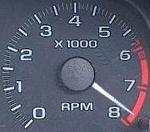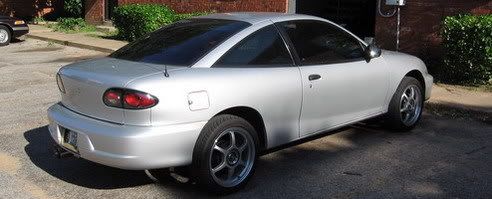PULSTAR: New Type of Spark plug - Performance Forum
Forum Post / Reply
You must log in before you can post or reply to messages.
I saw this today in a Popular Science magazine, It is a new type of spark plug that has a built in capacitor. Supposedly creates a 1,000,000 watt pulse of electricity that ignites fuel better. The company claims better fuel mileage, horsepower, and torque. It's new so I haven't actually found a review, but their is a lot of doubt on other forums about it. Just curious what the JBO community thinks

Here is the link to the companies web site.
http://www.pulstarplug.com/
Well, the fact that it's rated in Watts is very misleading, and for that I say it's junk. Secondly, there's no way for the capacitor to charge before it fires...
 fortune cookie say: better a delay than a disaster
fortune cookie say: better a delay than a disaster
It's not exactly a capacitor, they call it a pulse circuit, I just thought of it as a capacitor.
best case scenario lets say it does charge off the spark and then fire hotter and harder....its gona put your timing a degree or two off in the time it takes to charge

My car may run 18s, but I can do your taxes in 10 seconds flat.
JBO lube - they would never have enough in stock and we'd never see RodimusPrime again
I did not read everything on there site, but it sounds what they are claiming could be fixed with a nice ignition system. Also for it to store energy wouldn't it have to take engery first. Meaning rob enegry from the previous fire to store?
Edited 1 time(s). Last edited Tuesday, July 03, 2007 4:40 PM
 FU Tuning
FU Tuning
^Id assume that it would do that on the first few sparks, on startup... I dont think theyd make something thats actually going to hurt performance or economy.
Im sure it works to some degree and its a good concept and all. I doubt that the gains from it are going to be very noticible, even on a dyno, or whatever kind of test there is for mileage.
Id like to see some numbers, if its worthwhile and actually makes a fesable difference in performance/economy, I dont see any reason not to give it a shot, no?
John Higgins wrote:I did not read everything on there site, but it sounds what they are claiming could be fixed with a nice ignition system. Also for it to store energy wouldn't it have to take engery first. Meaning rob enegry from the previous fire to store?
not really. A spark plug has far more time than necessary between discharges for it to build up a higher capicitance. But like already stated, it would essentially retard the stock timing, which would require advancing the timing accordingly.
Edited 1 time(s). Last edited Tuesday, July 03, 2007 5:01 PM
-
"Youth in Asia"...I don't see anything wrong with that.
Matt Linke wrote:^Id assume that it would do that on the first few sparks, on startup... I dont think theyd make something thats actually going to hurt performance or economy.
quote]
doe no one remember the post a few months (maybe a year) back about the Nology Hotwires?
they claim a hotter harder spark by the spark plug wires using a type of capacitive charge. the wire itself charges up and though it does fire hotter and all that, it does exactly what Machzel said and thows the timing off.
thats not good. for performance or economy, its just not good.

1997 RedR - ZedR
I don't think it takes energy. In a normal spark plug there is a period were the charge builds enough so it can overcome the resistance in the gap. They claim in their plug a separate circuit collects the energy normally used for breaking that resistance barrier and at the right time releases it at once.
I think of it like this: If resistance were a wall, a traditional spark plug would be like getting people to push the wall one person at a time continually adding people until it finally collapsed. Theirs is like getting enough people, and then telling them to charge towards it all at once. The resistance is the same in both instances, just one way will break down the wall faster.
No matter what it does, Id like to see some proof of it doing so. I havent looked around their site too much, but id want 3rd party analysis either way.
Until there's definitive dyno sheets posted, assume the below:

1989 Z24 Convertible - Dust Covered
2006 tC - Dust Covered, but driven more
25 dollars each plus shipping. That sure is expensive.
--------------------------------------
04 Cavalier LS Sport- Red with factory silver stripes.
16.186 @ 86.98mph
David Arestie wrote:I don't think it takes energy. In a normal spark plug there is a period were the charge builds enough so it can overcome the resistance in the gap. They claim in their plug a separate circuit collects the energy normally used for breaking that resistance barrier and at the right time releases it at once.
I think of it like this: If resistance were a wall, a traditional spark plug would be like getting people to push the wall one person at a time continually adding people until it finally collapsed. Theirs is like getting enough people, and then telling them to charge towards it all at once. The resistance is the same in both instances, just one way will break down the wall faster.
no plugs are either firing or not
when its not firing there is no power...so that theory is out thw window

My car may run 18s, but I can do your taxes in 10 seconds flat.
JBO lube - they would never have enough in stock and we'd never see RodimusPrime again
Lets all pitch in a buck to buy a set of these plugs and have Dave give us a review. Who knows it may be the secret that lets our engines scream. lol
I'll front the dyno time, same as my electric turbo challenge, if someone wants to send me a set.

I guess if the plug charges and fires on it's own. It could mean that you dont need ignition coils to do the job.
Just a thought.

Lame, and worthless all rolled into one. It's a gimmick mod. They'll get a few tools to buy sets of wonder plugs, I won't be one of them.
Delco Platinums, or NGK Iridiums FTFW!

volts x amps = watts
typical ignition system produces 38,000 volts
typical delco ignition produces _____ watts ( I will fill in the blank after we run the math)
watts / volts = amps
1,000,000 / 38,000 = 26.3 amps
A gm DIS ignition actually produces .8 amps of secondary current.
If it could produce 26 amps, due to less than perfect superconductor materials being used to make it, it would take the whole system about 50 amps input current (being fed to it ) to even get close.
there is no free lunch, it takes more power in to make less power out. If the system only makes 30,000 watts without their unit ( and it does), then with any additional circuitry added it will only make less as a result.
Also, what was already said is correct.... the plugs do not have power at any other time than the 1 msec it takes to fire them. The circuit is completely dead at all other times.
sig not found
Ha ha ha, I just looked at their "how it works" on their site.
EVERYTHING THEY SHOW YOU IS FALSE/WRONG!!!!
-Their illustration of how the ignition fires is wrong. A the power for a spark is produced when the magnetised coil is turned OFF and the magnetic field collapses.
-The amount of power they say stock produces (50 watts) is wrong.
-Their claim that the spark controls combustion speed is wrong. After the spark ignites the mixture, the speed is controlled by how fast the mixture is moving (swirl), how much pressure it is under (compression), and how hot the mixture is (heat generated during compression). As long as the spark is strong enough to light the mixture, the amount of excess power above what it took to jump the gap has no effect whatsoever.
There is also another manufacturer claiming the same thing about their plug wires too, Dont remeber who though.
sig not found
not backing them up cause it does sound funny i think to but youhave to think our cars work ona waste spark system. so technically when the wasted cylinder is sparking it could get the added charge for when it fires on the compression stroke next round.
just a thought

The one, the only, ME.

Screw it! I'll just wait 'til they perfect the Rail Plug the the government has been developing in Texas on a CNG fueled LN2 that I've stumbled upon info about in a search on my engine that shows results from early testing of in the mid-to-late '90s. I'll share it as soon as I figure out how to post it.
Go beyond the "bolt-on".
the question still remains, where the hell is this power coming from that is charging the circuitry?
the power traveling into the spark plug is the same, and as far as i know can not be changed. this wonder plug produces more output power than a traditional plug does, yet has ADDED circuitry in it... where is this power coming from? something has to power it. you can't get something for nothing.
Kirchoffs (sp?) deems this impossible... power out = power in - losses
there will be voltage drop in the spark plug wire due to resistance (most wires i have seen are at best 50 ohms/foot), voltage drop in the plug itself again due to resistance, and in the circuitry remarkable again due to resistance.
the spark plug wire (if the vehicle has a spark plug wire) is more than likely going to remain unchanged. the spark plug itself is probably just some random off the shelf spark plug that is prefabricated and just stuck in this mix. even the resistance of the same type of plug even created one right after the other on the same damn production line will have different resistance from each other.
now you stick another circuit on it that also contains resistance and your just adding to the problem. so unless these spark plugs are especially created to be of an even lower resistance than the 5 or 6 ohms a normal plug has, this is crap. not to mention that this circuitry is going to more than likely add capacitance to a system that already has capacitance in it... that wont make the power factor any better.
either that, or you have just broken keirchoffs voltage law.... and thats just dandy.
the best thing you can do for your car when it comes to spark plugs is meter the plugs and the wires for resistance.
you take the longest plug (which should have the highest resistance) and match it up with your lowest resistance spark plug, and match your shortest and lowest resistance wire and match it up with your highest resistance plug. thats about all you can do shy of getting low resistance plug wires, and even then i would still recommend doing this.
have fun....
rob.
 1997 RedR - ZedR
1997 RedR - ZedR
Protomec, my apologies, your math is flawed. Your formula is correct, but your theory is not. Your math is for a steady state DC circuit. Power = Current X Volts is fine for light bulbs, however what is involved here is more complicated. First off, coils and wires have inductance in them. The inductance in both the wire and the coil create a rise time of the voltage over time. So the spark plug is part of this LRC circuit, or an inductance, resistive, capacitance circuit. As the voltage rises in the secondary of the high voltage coil, the capacitor in the spark plug begins to charge. The charging current of the capacitor is calculated, by I= C dv/dt. This means that the amount of current required to charge the spark plugs capacitor is based on the size of the capacitance with respect to the change in voltage over the change in time. So for a small capacitor that is in the spark plug (probably about 100 nano farads), the amount of current to charge this capacitor is small, however, it must charge it quickly, kind of like the police light strobes on top of their cars. Also the amount of charge or energy on the capacitor is calculated by E=C*V*V/2 (energy is equal to one-half C times V squared). Once the capacitor reaches full charge, it either discharges due to the potential across the spark gap or is triggered from some external source. The energy released by the capacitor is not in Watts, but in Joules. Watts is joules per second. One Joule is equal to one watt-second. So if the spark plug fires 10 times per second, and each pulse is 1 joule, then the total power is ten watts. However, that is average power, not peak power. The energy the advertisement is talking about is peak energy. Peak energy is based on pulse width and pulse width is based on the design of the spark plug and other factors, something they don't actually say. So do they get out one million watts? Yea, maybe, but is peak energy that is very short in time, probably nanoseconds long. The average power is still just 50 Watts. It gets more complicated then that. However, it is the same basic theory that is used to fire camera strobes, lasers, ect. That being said, doing the math, my car gets 34 miles per gallon. The advertisement reads a 2.7 percent increase in gas mileage. So that mean I would get about 35 miles per gallon. At $2.80 per gallon, it would take me 43000 miles to get my $100 back (four cylinder). I'd buy them at $10 a plug, not $25
I read about a plug that Firestone put out back in the 50s or 60s that had polonium in the tip. Yep, radioactive material, supposedly the ions discharged from the tip would make for a better spark. Thing is, polonium has a half life of about 168 days, so even if that claim held water, they wouldn't do it for long. Needless to say, you can't get polonium tipped plugs anymore. haha

One million watts, or in other words, one gigawatt is what they're saying the produced discharge is. Ha! Judging from the more enlightened, in-depth analysis, they might as well say one jiggawatt. Or even 1.21 jiggawatts! If that were possible, we could just put these plugs in our cars and just drive them back to a time when fuel that was designed for use in their engines cost just a micro-fraction of what it costs today comparatively. Or just go forward and get a Mr. Fusion home fusion reactor drive system installed.
Go beyond the "bolt-on".
Forum Post / Reply
You must log in before you can post or reply to messages.











